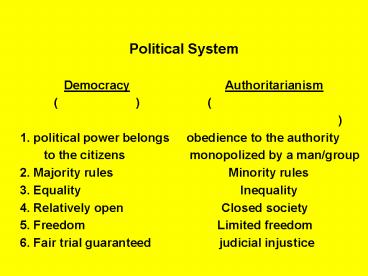Political System - PowerPoint PPT Presentation
1 / 12
Title:
Political System
Description:
Political risk is different from Sovereign Risk , which is the risk of ... Political. Economic. orientation. Economy size $10.2 Trillion 4.2 triilion ... – PowerPoint PPT presentation
Number of Views:11
Avg rating:3.0/5.0
Title: Political System
1
- Political System
- Democracy
Authoritarianism - ( )
( -
) - 1. political power belongs obedience to
the authority - to the citizens
monopolized by a man/group - 2. Majority rules
Minority rules - 3. Equality
Inequality - 4. Relatively open
Closed society - 5. Freedom
Limited freedom - 6. Fair trial guaranteed
judicial injustice
2
Economic System
- A) Resource Allocation
- 1. Market
- 2. Planned (Command)
- B) Ownership style
- 1. Private
- 2. Public
3
- Political - Economic Synthesis
- A) Political System B) Economic
System - a)
Resource b) Ownership - 1. Democracy Market
Private ( ) - 2. Totalitarian Planned
Public ( )
- Socialism
Capitalism - Problem
- Reason
- Correction
- Variation
4
- Political Risk
- Definition
- Political risk is different from Sovereign
Risk , - which is the risk of (
). - Major elements of Political risk
5
- Political Risk
- A. Macro Risk
- Risk of dramatic abrupt changes in biz
environ. - that will influence all foreign operations.
- (e.g.
) - B. Micro risk
- Risk of less dramatic but more prevalent changes
- in biz environ. that will influence only a
specific - firm/industry.
- (e.g.
)
6
- Political
Risk - Possible outcome
- a. b.
- c. d.
- e. f.
- g.
- Forecasting Political Risk
- a. ASPRO index by Shell Oil Co.
- b. BERI index by Business International
Corp. - c. PSSI index by (Haendel-West).
- d. IRIS index by PRS group
7
- Inverted U-curve
Theory - Country Political Frustration (expectation
- econ. reality) - risk
income - LDC
- NIC
- Developed
- political
- risk
-
level of - low middle
high income/ -
development
NICs
high
Developed
LDC
low
8
- China
India - Political
- Economic
- orientation
- Economy size 10.2 Trillion
4.2 triilion - (
7,700/capita)
(3,800/capita) - Unemployment 4.2
7.8 - Savings rate 50
26 - Socio-cultural
- Population 1.32 bil
1.1 bil - religion not a serious factor
serious factor - (
(multi-religious) - language Chinese
English - advantage
9
- Currency Crisis
- Typical Pattern
- 1. growing economy.
- 2. foreign capital inflow.
- 3. stock/real estate market boom.
- 4. buy, spend and borrow more.
- 5. debt exceeds beyond their capacity.
- 6. foreign banks stop lending.
- 7. risk of default (sovereign risk) rises.
- 8. foreign capital outflow.
- 9. stock market crash.
- 10.currency crisis.
10
- Causes of the crisis
- 1.
- 2.
- 3.
- 4.
- US concerns
- 1)
- 2)
- 3)
11
- Two theories associated with Latin countries
- Modernization vs. Dependencia
- Modernization theory it placed the blame for
under- - development on cultural values they are
under- - developed because their societies are
insufficiently - modern, socially and psychologically.
Underdevelop- - ment is thus a locally rooted problem such as
culture. - Dependencia theory In favor of a neo-Marxist
formulation, - it placed blame on the process of world
capitalist - integration under which a group of countries
are - deliberately situated to be dependent and
exploited by - some dominant countries. It contends that the
problem - of underdevelopment could not be solved
individually - unless otherwise the whole international
system changes.
12
- Calvo Doctrine
- The Calvo Doctrine is a foreign policy doctrine
which holds that - jurisdiction in international investment
disputes lies with the host - country where the investment is located. An
investor, under this - doctrine, has no recourse but to use the local
courts, rather than - those of their home country. The principle,
published in 1869 by - Carlos Calvo, an Argentine jurist, has been
applied throughout - Latin America and other areas of the world.
- It has since been incorporated as a part of
many Latin American - constitutions, as well as many other treaties,
statutes, and - contracts. The doctrine is used chiefly in
concession agreements, - the clause attempting to give local courts
final jurisdiction and to - obviate any appeal to diplomatic (or armed)
intervention.































